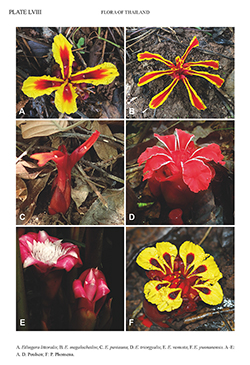e-Flora of Thailand
Volume 16 > Part 2 > Year 2023 > Page 498 > Zingiberaceae > Etlingera
13. Etlingera pavieana (Pierre ex Gagnep.) R.M.Sm.wfo-0000415727
Notes Roy. Bot. Gard. Edinburgh 43(2): 248. 1986; Poulsen & Phonsena, Nordic J. Bot. 35: 467. 2017.— Amomum pavieanum Pierre ex Gagnep., Bull. Soc. Bot. France 53: 141. 1906; Fl. Indo-Chine 6(1): 105. 1908.— Achasma pavieanum (Pierre ex Gagnep.) Loes., Nat. Pflanzenfam., ed. 2, 15(A): 596. 1930. Plate LVIII: C.
Accepted Name : This is currently accepted.
Description : Rhizome long-creeping, subterranean, slender, cream, only pubescent near apex or when scales are intact, scales to 3 cm long; stilt roots absent. Leafy shoots to 0.7–2.5 m long; base to 1.4–2.5(–3) cm diam., deeply striate and reticulate; ligule to (5–)7–9(–11) mm long, entire, rounded, ± pubescent, margin ciliate; petiole to 0.9–2.5 cm long, slightly winged, canaliculate; blade narrowly obovate, to 17–50 by 3.2–10 cm, length to width ratio 4.6–6.8, smooth, dull mid-green to dark green, glabrous, base cuneate to attenuate, oblique, apex shortly acuminate, margin ciliate in upper half. Flowering shoot 8–15 cm long, radical; receptacle 3–7 mm long, with 7–24 flowers, 1–3(–5) open at a time; peduncle subterranean, 2.5–11 cm long, pubescent; peduncular bracts to 2.8–4.5 by 1.2–2.5 cm, upper closely appressed to and covering base of spike; spike 5–7 cm long (including flowers), flowers extending vertically 2–3.5 cm above bracts; spike only including bracts spindle-shaped to ovoid, 3–6 by 1.7–3 cm; sterile bracts absent (rarely 1–2), in most cases axis nearly visible below lowermost fertile bracts; fertile bracts 2.8–4.7 by 0.5–2.2 cm, oblong to obovate, upper narrower, canaliculate, mucronate, cream in lower half, pale pink to dark red in upper half, pubescent to puberulous, margin ciliate; pedicel 0.5–1.5(–4) mm long, below bracteole, pubescent; bracteoles 2.2–4.2 cm long, pubescent, apex bilobed, apices close together, 2–2.8 cm below apex of calyx, densely ciliate. Flower 6.2–9.8 cm long (when straightened); ovary 3–5 by 3–4 mm, ± cylindrical, densely sericeous; style 4.5–7 cm long, hairy in upper 5 mm, flexistylous; stigma 2–3.5 mm wide, white or pale pink, with scattered short hairs, ostiole narrowly elliptic, transverse ca 1.5–2 mm, facing forwards; epigynous gland 4–6 mm long, split to base dorsally and variously on opposite side, sometimes bilamellate, apex irregularly toothed; calyx 4.3–6.4 cm long, reaching 0.7–1.7 cm short of apex of corolla lobes, hirsute, apex trilobed, apex pointed, lobes ± close together, tufted, slightly mucronate; floral tube (3.1–)4.5–6.2 cm long, glabrous or with scattered hairs on staminal tube, tube inside densely hairy in a band of about 3 mm at (or about 3 mm below) insertion of dorsal corolla lobe outside, hairs ± extending into staminal tube; lobes dark red, dorsal lobe reaching at least to apex of anther, dorsal lobe 2.1–3 by 0.7–1.1 cm, narrowly ovate, apex rounded or rarely emarginate, lateral lobes 2–2.9 by 0.4–0.7 cm, narrowly ovate to elliptic, apex rounded (rarely emarginate); staminal tube 0.4–1.1 cm long; labellum pandurate, held at an angle to tube, 3–4.2 by 1.6–2.4 cm, red to orange red, glabrous or rarely with a few short hairs beneath, lateral lobes erect to involute, 1.6–2.4 cm across when flattened, margin slightly revolute, central lobe round, entire, 1–1.3 cm across, extending 1.3–2.5 cm beyond anther; stamen 1.1–1.8 cm long, red; filament 0.6–1 by 0.3–0.6 cm, widest at base, canaliculate, sometimes with a few hairs at base adaxially; anther 6–8 by 2.5–5 mm, widest near apex, angled 130–160°, red, margin at apex emarginate, incision 0.5–1.5 mm; thecae dehiscent 3–4 mm in centre, from 2–3.5 mm above base to 1–2 mm below apex, ± shortly hairy, especially at base. Infructescence only seen for E. pavieana subsp. pavieana (see below).
1. Leafy shoot 1–2.5 m. Inflorescence with 13–24 flowers a. subsp. pavieana
1. Leafy shoot < 1 m. Inflorescence with 7–12 flowers b. subsp. hirticalyx

